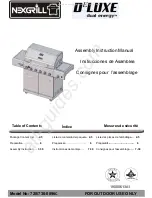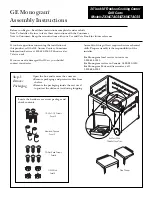
28
(
A)Direct Cooking Method (continued)
Most importantly, use the hood thermometer as a warning guide that the barbe
c
ue is too hot. For grilling most foods,
aim to keep the thermometer below 200ºC to avoid burning. Never let the temperature reach into past 250º Celsius or
the barbe
c
ue will overheat and burn your food.
A separate probe thermometer is available
for purchase from barbecue retailers
. This takes the
guesswork out of knowing when your food is cooked.
Barbe
c
ue Tip
Great chefs will tell you that most meats need to “rest” away from the heat of the barbe
c
ue before slicing for a few
minutes to allow the moisture pushed to the surface to redistribute. If you don’t rest the meat, moisture that has pooled
near the surface will run out and the rest of the roast will be quite dry. Use the few minutes while resting the meat to
open the barbe
c
ue hood, turn all burners to
Hi
for 2 or 3 minutes to burn off food residue. After 3 minutes, turn the
barbe
c
ue
OFF
. While the cooking surfaces are still hot, take a long handled brush or scraper and remove remaining oil
and food residue. You should use an oven mitt to avoid burns. 3 minutes now will save 30 minutes next barbe
c
ue.
Always remember to switch the barbe
c
ue OFF once you are finished cooking.
(B) Indirect Cooking Method
This is when you place the food only above burners that are
OFF
. The other burners are adjusted in combinations
of
Low
and
OFF
to maintain constant lower roasting temperatures. This method is ideal for thicker cuts of meat,
legs of lamb, pork, shoulders of beef, whole chickens and whole fish.
Moist, hot air rises from the lit burners and circulates around the food, trapping juices and flavor. Even cakes and
breads can be cooked in your barbe
c
ue this way. Cooking low and slow lets the food cook completely through without
burning on the outside, yet remaining juicy and tender on the inside.
Best results are achieved by placing your roast in a rack and that rack in a drip pan. The roast is elevated to allow heat
to circulate all the way around, and water, wine, juices, herbs can be added to the drip pan to help flavor the roast and
make a baste or gravy.








































